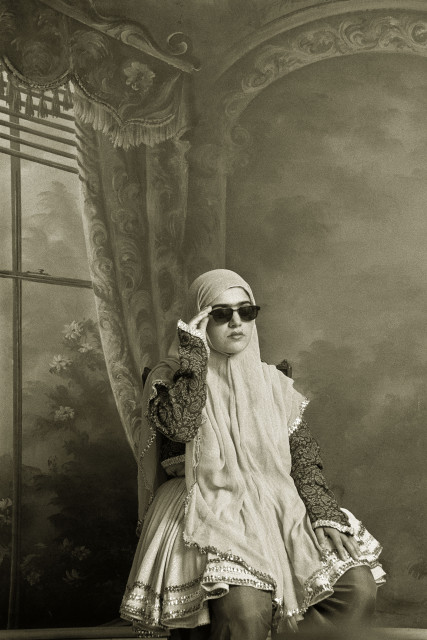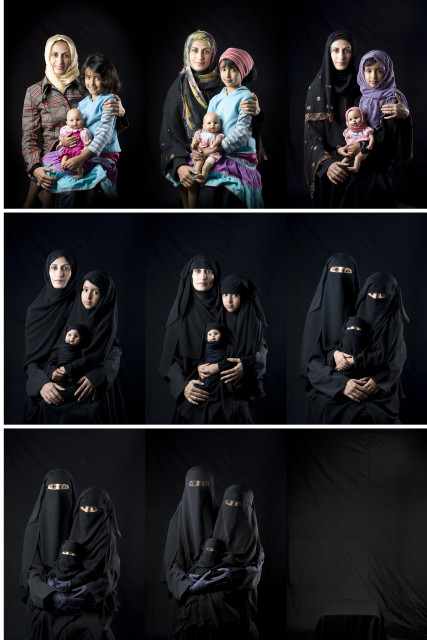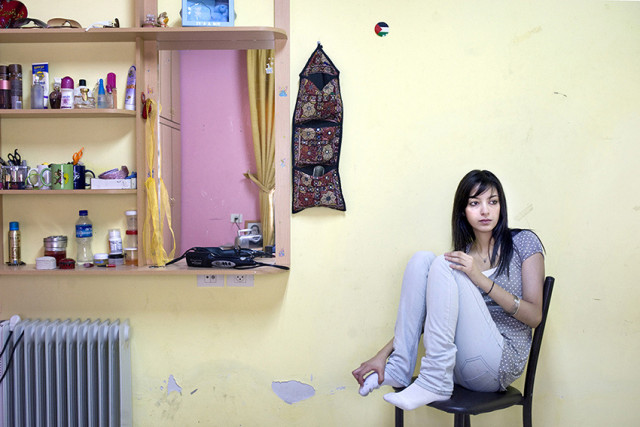Western news outlets have closely followed the story of Sajida al-Rishawi, an Iraqi woman with ties to ISIS who currently sits on death row in Jordan. What’s striking about the commentary to date is the surprise expressed that al-Rishawi—and like her, Hayat Boumeddiene, who was sought as an accomplice in the massacre of journalists at the office of French satirical newspaper Charlie Hebdo—could carry out such violent acts. That surprise is telling, for it illustrates the psychological constructions to which Middle Eastern women are often reduced: the hapless innocent with little ability to resist fundamentalism, or else the murderous zealot whose radicalization was inevitable.
Challenging those staid notions is an intimate exhibition now on view at the Cantor Arts Center at Stanford University. She Who Tells a Story: Women Photographers from Iran and the Arab World marshals the work of 12 contemporary artists to tell stories of lives that proudly and powerfully defy popular stereotypes.
Orientalism, a socio-political construct outlined by the late Palestinian cultural critic and theorist Edward Said, is the dominant schema by which Middle Eastern civilizations were situated for western audiences. Beginning in the mid-19th century, the advent of early photographic techniques allowed practitioners to build on the visual language already established by European artists including Jean-Léon Gérôme and Eugene Delacroix. On canvas and in photographs, Middle Eastern societies were presented as exotic, violent, inferior, and therefore beholden to their colonizing western counterparts for drawing them into the rapidly modernizing world.
Clik here to view.

It could be argued that all of the images featured in She Who Tells a Story were made as an interrogation or rejection of essentialist thinking, but there are specific bodies of work that illustrate how those challenges have changed over time. Lalla Essaydi—who along with Shirin Neshat, also represented in the exhibit, is arguably one of the better-known Arab artists in the contemporary art community—visualizes the female body as the prize of wholesale cultural consumption. Bullets Revisited #3 (2012) features a woman reclining on a low-slung bed in front of a gilded background. Looking closer, one realizes that the shimmering facets are not gold, but bullet casings. She is languid, available at least to our gaze, yet uninviting. She is contained, as women were thought to be controlled within physical spaces such as harems.
Essaydi’s performative practice addresses space as a gendered experience, identity, and isolation, all of which parallels her experience of growing up between eastern and western sensibilities. In this image, as in her earlier series Converging Territories (2003-04), calligraphy references the power of the word in Islamic culture. Her subject’s skin bears the mark of religion, while other material signifiers such as bullet casings reference the fearsome rise and bloody consequences of extremist factions such as ISIS and Al-Qaeda.
Where Lalla Essaydi represents the first wave of visual artists whose work both challenged the limitations placed on contemporary creative practice in the Middle East and aroused western attention, artists Boushra Almutawakel and Shadi Ghadirian, along with the other nine artists highlighted in the exhibition, represent the next generation of Middle Eastern artists. Mother, Daughter, Doll (2010) features two figures in a series of nine photographs. In the introductory frame, we see Almutawakel and her oldest child dressed in colorful yet conservative dress and seated before the camera. Over the course of the succeeding eight panels, color and expression vanish beneath a niqab, the full-length robe that leaves only a woman’s eyes visible.
Clik here to view.

It’s easy to see this series as reinforcing western stereotypes of Arab and Iranian women—veiled, submissive, “other”—but there is more to it. For some observant women, dressing conservatively protects them from an often hostile and unpredictable world. Almutawakel’s delivery is heavy-handed, but the series successfully presents both the stereotype with which we are all too familiar and the sense of security such sartorial choices allow.
Mother, Daughter, Doll is hung opposite Shadi Ghadirian’s Qajar series (1998), in which young Iranian women are photographed holding objects including a boombox, a Pepsi can, and musical instruments, and the two bodies of work convey how the artists subvert longstanding practices in photographic portraiture. Curator Kristen Gresh, who organized the exhibition for the Museum of Fine Arts in Boston, writes of Ghadirian’s work: “These humorous pastiches set up a cross-cultural and cross-temporal encounter.” In effect, we are witness to Ghadirian as she reconciles her own practice with history and contemporaneity, restriction and freedom, public and private.
Identity and its de/construction run throughout the exhibition, particularly as an intimate exchange between photographer and subject. Tanya Habjouqa’s Women of Gaza (2009) portrays female subjects engaged in a range of activities, including a family picnic on the beach and an exercise class. These moments are far from extraordinary, and it is their mundane familiarity that provides potency. Talk to almost anyone in the Middle East about what they want from life, and their answers may include safety, agency, and freedom. Habjouqa captures those fleeting moments, and the series is rendered all the more powerful by the realization that what she captured of Gaza was pounded into dust by Israel during the summer of 2014.
Clik here to view.

In similar fashion are Rania Matar’s photographs of girls on the verge of womanhood in their bedrooms. A Girl in Her Room (2010) offers a view of otherwise private spaces, where childhood is quickly overwhelmed by teenage interests and anxieties. While the entire series is engaging, I was stopped cold by Bisan, Bethlehem, West Bank (2009). Curled into a chair, her feet pulled up to the edge as she fidgets with her sock, Bisan gazes away from the camera as though lost in thought. What struck me about this composition was the tiny Palestinian flag attached to the wall above her head. What is identity, and how is it constructed, when national allegiance is proclaimed as more important?
Geopolitical conflict is another, and perhaps most important, aspect of life in the greater Middle East portrayed throughout the exhibition. Important because it shapes our understanding of past and present acrimony in the region, and because it renders other choices made by those who live in war zones all the more precious. Macro- and micro- views of conflict and its aftermath are represented in a smart cross-gallery installation of Jananne Al-Ani’s Aerial I (2011) and Rula Halawani’s Negative Incursions (2002). Al Ani’s work—production stills drawn from the single-channel digital video Shadow Sites II—captures places on the land that bear the marks of humankind’s creative and destructive potential. Al-Ani’s 1,000-ft. view suggests the prevalence and unemotional clarity of military surveillance and reminds us of the power of war to erase who and what once was.
By contrast, Rula Halawani’s series Negative Incursions documents Israel’s assault on Gaza in 2002, a portent of the atrocities that unfolded in the same region in 2009 and again in 2014. Trained as a photojournalist, Halawani abandoned press photography after years of forcefully separating herself from her subjects so as to maintain objectivity. Negative Incursions is the first series she produced after shifting professional gears. The large-format photographs are printed as negatives, and the reverse presentation has a disquieting effect. We know that we’re looking at tanks rolling through the streets of Gaza, and at bodies cut down by gunfire, but the clarity and “truth” thought to be conveyed by the photographic image is unclear. The absence of the the body in Al-Ani’s work and its obscured presence in Halawani’s work render these images as powerful pendants.
She Who Tells a Story succeeds as a presentation of photographic work by women throughout the Middle East. While the subjects, aesthetic choices, and range of photographic practices represented is narrow and at times repetitive, the installation builds on the momentum created by other recent exhibitions, including Here and Elsewhere and View from Inside, in which contemporary art produced throughout the Middle East is examined through a critical lens.